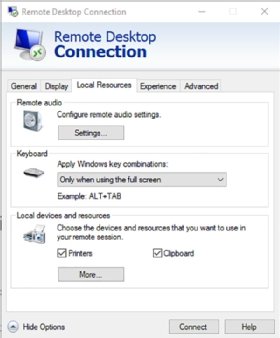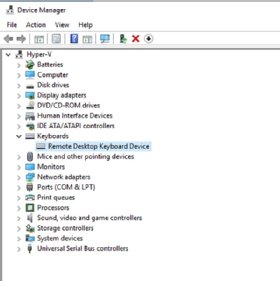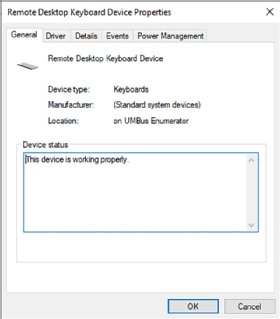
Getty Images
How to fix keyboard connection issues on a remote desktop
When the keyboard for a remote desktop isn't working, sys admins will need to run through these steps to find the root cause of the problem and address it.
One of the more frustrating issues that comes up when working with Remote Desktop Protocol is when a remote desktop's keyboard is not working.
This can happen because the remote desktop OS is running remotely and there is therefore no physical connection between the keyboard and the remote machine. Thankfully this type of problem is usually easy to fix. As a remote desktop administrator, you can follow these steps in the proper sequence to troubleshoot, find the root cause of and address any malfunctioning keyboard.
1. Make sure the keyboard is functional
If you are experiencing problems with the remote desktop keyboard not working, the first thing you should do is make sure the local hardware is functioning properly. After all, if the keyboard isn't working properly on the local computer, then it cannot be expected to function within a remote desktop. To test the keyboard, try opening an application other than the remote desktop client and typing a few keystrokes. If your keystrokes appear on the screen, then the keyboard is functional.
You also need to consider if a keyboard is largely functional, yet still somewhat problematic for UX.
A wireless keyboard, for example, may not be suffering from any hardware problems, but could be experiencing radio interference. When this happens, there may be a significant lag as keystrokes are typed or a user may notice that keystrokes are completely omitted. In extreme cases, you may even find that most of the characters they type never appear on the screen.
If this happens, then there are two things you should check. First, make sure the wireless keyboard is turned on and stays turned on. Most wireless keyboards have a power switch on the underside of the keyboard. There could be mechanical issues with a keyboard where the power switch is a little too sensitive. Subtle movements could shift the power button off.
Of course, the best plan is to avoid any keyboard with these issues in the first place, but in a pinch you could find some way to hold the power switch in the correct position with tape. While this fix is inelegant, it may be the only short-term fix possible. You should phase out any hardware that creates issues such as this during your next hardware refresh.
One final step is to determine if the keyboard's receiver is installed in a location that will allow it to perform optimally. Consider an example of a keyboard lag issue. This might occur because the receiver was installed in a USB port on the back of the computer case and the large metal case was blocking a lot of the radio signals. Relocating the receiver to a USB hub could fix the problem.
2. Determine if the problem is specific to a certain application
If you are having problems with the remote desktop keyboard not working, it may be worth checking to see if the issue is specific to a particular application that is running in the remote desktop.
To do so, log into the remote desktop and open a basic application such as Notepad. If you find that you can use the keyboard in Notepad, but not in a particular application, then the problem is specific to that application. Otherwise, the problem pertains to the RDP session as a whole.
3. Check to see if another window is selected
The next step is to see if the remote desktop client is selected as the active window. This step sounds almost too simple to be the root cause, particularly for those who have a lot of experience using Windows, but it can cause issues for even the most experienced administrators. If you are running a remote desktop session in a window and an application on your local machine is selected, then keystrokes will be directed to the local hardware rather than to the remote computer.
If the remote desktop session is selected, try pressing the Windows key a few times. Some remote desktop keyboard issues can be resolved by pressing this key several times.
4. Review the Remote Desktop Client settings
If you have been unable to resolve your problem after steps 1-3, then the next logical step is to make sure the remote desktop client is configured correctly. Assuming you are using the native Windows Remote Desktop Connection client -- which is often referred to as the Remote Desktop Protocol (RDP) client or simply the Remote Desktop client -- this is a relatively simple process.

To get started, open the Remote Desktop Connection client, but do not click the Connect button. Instead, click on the Show Options link located in the lower left corner. This will cause the Remote Desktop Connection window to expand, revealing several additional options. You will see several tabs displayed just beneath the Remote Desktop Connection logo. Select the Local Resources tab.
The Local Resources tab contains a Keyboard section (Figure 1). By default, the Remote Desktop Connection client is configured to direct key combinations -- but not all keystrokes -- to the remote machine only when the client is running the remote computer in full-screen mode. You can change this behavior by selecting the On the remote computer option from the keyboard drop-down menu.
5. Check the Device Manager on the remote desktop
If you are still having problems with the keyboard in your Remote Desktop session, check the Device Manager to see if the Windows OS is reporting any problems with the keyboard.

The exact method for this step varies slightly from one version of Windows to the next. For most newer Windows OSes, however, you should be able to right-click on the Start button, then select the Device Manager option from the resulting menu. When the Device Manager opens, expand the Keyboard section and make sure the Remote Desktop Keyboard Device is listed (Figure 2).
Normally, if the Remote Desktop Keyboard Device is having any problems you will see an error or a warning icon superimposed over the keyboard icon. However, there is another way to check for issues with the remote desktop's keyboard. Simply right-click on the Remote Desktop Keyboard device and select the Properties command from the shortcut menu.

The resulting screen will display a status and will tell you whether or not the device is working properly (Figure 3). If the issues persist, you can use the Driver tab to make sure the correct keyboard driver is loaded.
You haven't been able to fix the keyboard issue with these steps: Now what?
You may be able to narrow down the problem by trying to connect to a different Remote Desktop environment and see if the keyboard works there. Similarly, you might try connecting to the problematic Remote Desktop from a different PC and test that other endpoint for keyboard or other issues.
Doing so will tell you whether the problem exists on your local machine or at the Remote Desktop level. If all else fails, try looking through the Windows event logs to see if the logs contain any hint as to what may be going on. This will give you any public knowledge on the topic, and provide any known fixes to resolving the issue.




